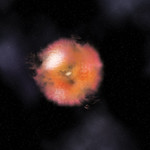Discovery News; online article:
http://dsc.discovery.com/news/2007/08/01/blackholes_spa.html
August 1, 2007
By Larry O'Hanlon, Discovery News

Some of the cosmos' biggest monsters have been hiding, say Japanese and U.S. X-ray astronomers who have now spotted several hundred super-massive black holes at the hearts of as many galaxies.
All of the black holes found are the super-massive sort, which live only at the centers of galaxies. But unlike others that have been detected by the visible and ultraviolet light streaming from doomed matter as it falls into oblivion, or from the infrared glow of hot gases heated by these screams, these gigantic black holes appear to be completely hidden in immense shrouds of dust. Only the highest-energy "hard" X-rays escape.
"The thicker the dust and gas is, the higher the energy needed to get through it," explained astronomer Richard Mushotzky of NASA's Goddard Space Flight Center.
It was NASA's Swift Burst Alert Telescope that started to detect the high energy X-rays leaking from what are called Active Galactic Nuclei (AGN) two years ago.
The discovery appears in a report in the August 1 issue of Astrophysical Journal Letters.
The confirmation of the newfound super-massive black holes came after taking aim with the Japanese/U.S. Suzaku X-ray telescope, which can detect and observe a broader range of X-ray energies than Swift. Both telescopes operate in space, since Earth's atmosphere blocks cosmic X-rays from reaching the ground.
Shrouded AGN were a surprise for astronomers and astrophysicists. According to standard AGN theory, the galactic super black holes are supposed to have a donut of dust surrounding them. This means they should be more visible from directly above and below – through the galactic donut holes.
Just what sort of emissions astronomers have seen from AGN was usually a function of the angle of view of any particular galaxy.

"What we learned from Suzaku is these [galaxies] don't have a hole," Mushotzky told Discovery News. "It's basically a change in our understanding of the geometry."
The discovery of fully shrouded AGN also implies there are a larger number of galaxies with black holes in the act of eating matter.
"The thing that is really surprising that's beginning to emerge from these surveys is how common [AGN] are," said astronomer Christopher Reynolds of the University of Maryland, College Park. "The numbers of truly inactive galaxies are falling."
It could be, perhaps, that half of all galaxies have actively feeding black holes at their centers, he told Discovery News.
This, of course, begs the question: Why are some galactic black holes active while others are not?
At the center of the Milky Way, for instance, is a black hole as massive as three million suns that's not eating much matter at all, and so it's not sending out X-rays, Mushotzky said.
One possibility is that the space around most super-massive black holes is usually clear of material, and they are usually quiet. It's only when galaxies collide with each other that dust is dragged through a galactic center and a black hole gets to eat.
If this is true, many of those thousands of AGN seen near and far in the cosmos could be road flares of galactic collisions.